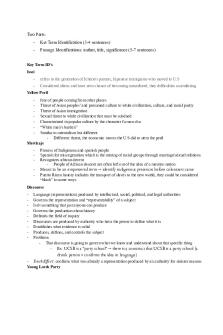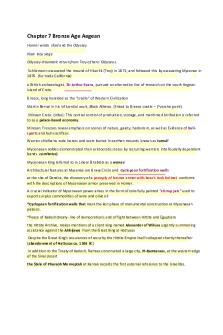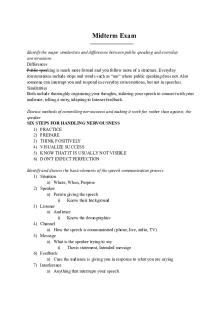BIPN 100 Midterm 1 - Professor Catalina Reyes-Gonzalez PDF

| Title | BIPN 100 Midterm 1 - Professor Catalina Reyes-Gonzalez |
|---|---|
| Author | Phoebe Zhang |
| Course | Human Physiology I |
| Institution | University of California San Diego |
| Pages | 5 |
| File Size | 158 KB |
| File Type | |
| Total Downloads | 32 |
| Total Views | 173 |
Summary
Professor Catalina Reyes-Gonzalez...
Description
Zhang 1
BIPN Midterm 1 I. Osmolarity: takes into account the penetrating & nonpenetrating solutes; measures solutes in solvent; before equilibrium II. Tonicity: takes into account only the nonpenetrating solutes; measures movement of water; response to osmolarity; after equilibrium; change in cell size A. Urea & sucrose penetrate (do not dissociate), Na+ & Cl- do not penetrate III. Equilibrium potentials: E = 61[log(out/in)] A. More negative moves toward less negative IV. Na+ K+ pump/Na/K ATPase: electrogenic A. bUses 70% of basal metabolism B. Electrochemical gradient 1. Na+ K+ pump contributes to concentration gradient (5 mV) 2. K+ contributes to electric gradient (85 mV) a) K+ moves out, down concentration gradient b) (-) cannot follow b/c membrane 3. Concentration gradient = electrical gradient @ equilibrium potential a) Concentration gradient pushes K+ out of cell b) Electrical gradient pulls K- into cell C. I = V/R = (V-E)(G) = (driving force/electrochemical gradient)(pathway/permeability) D. Rising phase: Na+; peak membrane potential = +30 mV, not +60 b/c: 1. Voltage-gated K+ channel opening 2. Na+ channel inactivation 3. When membrane potential approaches reversal potential, ions move more slowly b/c smaller driving force E. Falling phase: K+ V. Components of the Nervous System A. Sensory (peripheral) B. Integrative (central) C. Motor 1. Somatic (voluntary) 2. Autonomic (involuntary): parasympathetic & sympathetic VI. Microscopic Components of the Nervous System A. Neurons: handle info; functional unit of the nervous system 1. Anaxonic: axons cannot be distinguished from dendrites; interneurons of CNS 2. Bipolar: 2 processes separated by cell body; sensory (afferent) 3. Unipolar: 1 process w/ cell body to the side; sensory (afferent) 4. Multipolar: > 2 processes, multiple dendrites, single axon; motor (efferent) 5. Tract: bundle of axons in CNS 6. Nerves: bundle of axons in PNS; extend from the CNS a) Sensory nerves: carry afferent signals (PNS → CNS) b) Motor nerves: carry efferent signals (CNS → PNS) c) Mixed nerves: carry signals in both directions 7. Nucleus: group of cell bodies in CNS 8. Ganglia: group of cell bodies in PNS B. Glial cells: hold neurons together; 10-50 glial per neuron 1. Oligodendrocytes: form myelination 2. Astrocytes: maintain blood-brain barrier 3. Microglia: remove waste & pathogens 4. Ependymal cells: surround ventricles (brain) & central canal (spinal cord); monitor & maintain CSF 5. Satellite cells: maintain environment of neurons in PNS 6. Schwann cells: form myelination VII. Electrical Transmission A. Neuron 1. Depolarization: increase permeability for Na+ → Na+ moves into the cell, down its
Zhang 2
electrochemical gradient → inside becomes less negative Repolarization: increase permeability for K+ → K+ leaves the cell; inside becomes more negative 3. Hyperpolarization: increase permeability for Cl-; inside becomes more negative B. Types of Voltage Changes 1. Graded potentials (passive propagation): loses strength b/c leak channels 2. Action potentials a) If graded potential is above threshold @ axon hillock (signal integration center), then it generates action potential b) Resting membrane potential → stimulus → voltage-gated Na+ channels activate w/ depolarization → rapid Na+ entry → Na+ channels inactivate @ +30 mV & slower K+ channels open → K+ exit & hyperpolarization → voltage-gated K+ channels close → resting membrane potential c) Frequency & recruit more neurons to tell how large action potential is 3. Voltage-gated Na+ channels a) Activation: activation gate opens → sodium moves into the cell b) Inactivation: inactivation gate closes (a few milliseconds later, timedependent) → sodium cannot move into the cell (peak of action potential), stops @ +30 mV, not +60 mV c) Deactivation: resets (close activation gate & open inactivation gate) if repolarization happens 4. Voltage-gated K+ channels: only 1 gate a) Hyperpolarized phase: K+ keeps leaving the cell until it reaches its equilibrium potential (goes below -70 mV) b) Sodium moves into cell through leak channels → back to -70 mV 5. Action potentials a) Local voltage-gated Na+ channels activate next batch & next batch, etc. (why they don’t lose strength) b) Doesn’t go back b/c refractory period (allows K+ out of the cell so Na+ doesn’t backflow; inactivated state) 6. Refractory period a) Absolute refractory period: Na+ channels inactivated, Na+ inside repels & keeps positive inactivation gate closed → new stimuli do not lead to new action potentials; ends when inactivation gates open b) Relative refractory period: sodium channels repolarized; K+ channels still open → K+ moves out → greater distance from threshold → need more to generate second action potential @ hyperpolarized phase) 7. Conduction velocity of action potentials depend on: a) Axon diameter b) Myelination: oligodendrocytes & Schwann cells; prevents ion leakage c) Nodes of Ranvier: sections w/out myelination, alternate d) Saltatory conduction: allows more sodium into the cell; hop/leap from one node to next, increases conduction velocity 8. PNS fibers a) A: largest, myelinated, highest conduction velocity; alpha (largest), beta, gamma, delta (smallest) b) B: medium, myelinated c) C: small, not myelinated, slowest Synaptic transmission A. Electronic transmission: cells connected by gap junctions, APs can go both directions; fast; in CNS, cardiac muscle & smooth muscles B. (2) Chemical/synapse transmission: presynaptic cell molecules bind to postsynaptic cell receptors, unidirectional, can modulate better (release a bit or a ton of stimuli) 2.
VIII.
Zhang 3
1. 2.
C. D.
E.
F.
G.
H.
Neuromuscular junction (NMJ): alpha motor neuron & skeletal muscle Activates P/Q-type voltage-gated calcium channels in the presynaptic terminal → calcium moves down its concentration gradient 3. Calcium signals presynaptic vesicles to move & fuse w/ cell membrane of presynaptic terminal 4. Presynaptic vesicle contains acetylcholine → exocytosis of acetylcholine into synaptic cleft → binds to nicotinic muscle acetylcholine/cholinergic muscle receptors (nAChRs) @ motor end plate in NMJ 5. Activated ligand-gated receptor (ionotropic) allows ion movement (Na+ in & K+ out of cell; driving force causes Na+ to move into the cell → Na+ generates end platepotential (EPP) [graded potential] b/c depolarizes 6. Na+ activates Na+ channels → more Na+ comes in → generates muscle action potential if EPP is above threshold Quanta: nt release into a synapse from vesicles 1. Each quanta generates miniature end-plate potentials (MEPP) 2. Sum of MEPPs generates EPP (graded) Mechanisms of nt termination 1. Calcium diffuses (fast) & ATPase pumps move intracellular Ca+2 to ECF (slow) 2. Nt dissociates from receptors (fast) & is removed (broken down by enzymes, taken up by glial cells, or waste) a) Acetylcholine unbinds from receptor → acetylcholinesterase (AChE) breaks down into choline (taken up by presynaptic terminal to be reused, sodiumcholine cotransporter b/c sodium wants to move into the cell & choline gets free ride) & acetate (waste) 3. Choline-acetyltransferase [CAT]: choline + acetyl CoA = acetylcholine (ACh) 4. Vesicular acetylcholine transporter moves acetylcholine into vesicles using ATP Floppy baby syndrome 1. Toxin produced by the bacteria Clostridium botulinum (same in botox) 2. Decreases acetylcholine release (exocytosis), not above threshold → no action potential Myasthenia gravis 1. Autoimmune (attacks nAChRs) → less acetylcholine can bind & activate receptors → less sodium can come in → less voltage-gated Na+ channels activated (lower endplate potential) 2. Take longer to get to threshold → less/no muscle potential/contraction 3. Causes muscle weakness (cranial) 4. Treatment: acetylcholinesterase inhibitor → a lot of acetylcholine available to bind 5. Too much AChE inhibitor → always EPP (depolarization) b/c acetylcholine always attached to receptors → Na+ always coming in → Na+ voltage-gated channels always activated → bigger & consistent EPP → activation gate opens & deactivation gate closes → repolarization cannot occur b/c constant flow of Na+ → channel remains inactivated Post-synaptic potentials 1. Excitatory postsynaptic potential (EPSP) [depolarizing]: nt → cation influx → postsynaptic neuron membrane depolarization → AP 2. Inhibitory postsynaptic potential (IPSP) [hyperpolarizing] a) Nt → hyperpolarizes → reduces the likelihood of AP b) GABA activates Cl- channels so Cl- moves into the cell c) Activates K+ channels so K+ moves out of the cell d) Inactive Na+ channels Nts: 1. Acetylcholine (contains nitrogen, derived from tyrosine & synthesized @ axon
Zhang 4
I. J.
IX.
X.
terminal b/c small) → cholinergic → nicotinic or muscarinic a) Nicotinic: found on skeletal muscle in NMJ, PNS & CNS (all excitatory) b) Muscarinic: GPCRs; excitatory/inhibitory; found in CNS & PNS parasympathetic division 2. Biogenic amines (synthesized @ axon terminal) a) Epinephrine: produced from the adrenal medulla, neurohormone b) Norepinephrine: main nt of the PNS sympathetic division c) Dopamine: midbrain; improves blood flow d) Serotonin: brainstem nuclei; constricts blood vessels e) Histamine: inflammatory agent 3. Amino acids (CNS, synthesized @ axon terminal) a) Glutamate: excitatory nt in CNS b) Aspartate: excitatory in some parts of the brain c) GABA: inhibitory nt in brain d) Glycine: inhibitory nt in spinal cord 4. Neuroactive peptides (synthesized in cell body b/c big) a) Substance P: in pain pathways b) Opioids: pain relief c) Endorphins: pain control 5. Gases a) Nitric oxide (NO): diffuses quickly & breaks down easily Types of synapses: one-to-one synapse (NMJ), divergent & convergent pathways Summation 1. Spatial summation a) Currents from simultaneous graded potentials, originating from different locations, combine b) Postsynaptic inhibition: inhibitory presynaptic neuron prevents an action potential from firing 2. Temporal summation: 2 or more graded potentials from 1 presynaptic neuron occur close together
CNS A. Meninges: layers of connective tissue b/w the bones & tissues of CNS 1. Dura mater: close to skull & spinal cord (dura = durable) 2. Arachnoid membrane: loosely connected to inner membrane/pia mater (looks like spider web) 3. Subarachnoid space: below arachnoid; CSF 4. Pia mater: innermost layer, in contact w/ brain & spinal cord B. Ventricles C. CSF 1. Choroid plexus: produces CSF; network of capillaries in ventricles 2. Arachnoid villi: absorb CSF 3. Function: buoyancy = less weight on spinal cord, protects from impact & provides good environment (blood-brain barrier: capillaries have astrocytes that promote tight junctions/are highly selective) Spinal cord A. Cervical (8 spinal nerves) B. Thoracic (12 spinal nerves) C. Lumbar (5 spinal nerves) D. Sacral (5 spinal nerves) E. Coccygeal (1 spinal nerve) 1. Superior (closer to the head) vs. inferior 2. Ventral/anterior (belly) vs. dorsal (back) 3. Medial (middle) vs. lateral (sides) 4. Ipsilateral (same side) vs. contralateral vs. decussation (crosses the midline) F. White matter: on the outside; myelinated axons (tract); carries info G. Gray matter (lateral horns): in the middle; cell bodies (nuclei); integrates info
Zhang 5
1.
Dorsal ramus/root ganglion/somatic sensory nuclei/horn: sensory info towards spinal cord (afferent) 2. Ventral horn/somatic motor nuclei/root/ramus: motor info away from spinal cord (efferent) H. Reflexes (no perception) & reflex arc 1. Sensory receptor & neuron 2. Integrating center: gray matter 3. Motor neuron: sends efferent signal to the effector 4. Effector: responds to the motor nerve impulse (muscle/gland) a) Proprioceptors: monitor position of limbs; in skeletal muscles b) Joint receptors: integrated in cerebellum, still reflex b/c not cortex; respond to mechanical distortion c) *Golgi tendon organ: responds to muscle tension; afferent signal → gray matter (inhibits alpha motor neuron) → causes relaxation; polysynaptic (sensory neuron → interneuron → motor neuron) d) *Muscle spindle: responds to muscle stretch/length; innervated by gamma neurons; ends are contractile/intrafusal fibers, middle is not contractile but has nerve endings (can increase firing); when muscle contracts/shortens, decreases stretch in spindle (stops firing) → problem b/c gives muscle tone & cannot give info about stretch → can damage muscle from overstretching); alpha-gamma coactivation: contraction of extrafusal & intrafusal fibers (only ends contract & middle stretches); monosynaptic 5. If contraction: alpha motor neuron activated, acetylcholine, nAChRs (excitatory) 6. If relaxation: sensory neuron → inhibitory interneuron → releases nt (glycine; activates Cl- channels → Cl- moves into the cell so less likely to reach threshold) → alpha motor neuron (decreases likelihood of alpha motor neuron → AP) a) Patella tendon reflex (knee jerk): spindles fire → dorsal horn (1) Quads contract (alpha motor neuron, NMJ); monosynaptic; glutamate (2) Hamstrings relaxed (inhibited alpha motor neuron); polysynaptic; glycine; antagonist (against nt) b) Crossed extensor reflex: divergent pathway (1) Quads relax: inhibitory interneuron (2) Hamstrings contract: alpha motor neuron (3) Opposite for opposite leg c) Tetanus (1) Toxin made by bacterium Clostridium tetani (2) Taken by somatic motor neurons (cell body in ventral root/gray matter) (3) Blocks nt release in inhibitory interneurons (4) Spasms → rigid contractions muscle paralysis (5) Treatment: penicillin (blocks receptor so acetylcholine cannot bind) (6) Interneurons constantly fire to prevent spasms d) Autonomic reflexes (1) Monosynaptic reflex: 1 neuron synapsing w/ another neuron (2) Polysynaptic reflex: multiple synapses...
Similar Free PDFs

BIPN 120 Midterm Notes
- 13 Pages

Catalina Robles Entregable 1
- 13 Pages

Astronomy 100 Midterm 1 Review
- 1 Pages

ABS 100 note - Professor Maufin
- 21 Pages

ENGL 50 Midterm - Professor Black
- 10 Pages
Popular Institutions
- Tinajero National High School - Annex
- Politeknik Caltex Riau
- Yokohama City University
- SGT University
- University of Al-Qadisiyah
- Divine Word College of Vigan
- Techniek College Rotterdam
- Universidade de Santiago
- Universiti Teknologi MARA Cawangan Johor Kampus Pasir Gudang
- Poltekkes Kemenkes Yogyakarta
- Baguio City National High School
- Colegio san marcos
- preparatoria uno
- Centro de Bachillerato Tecnológico Industrial y de Servicios No. 107
- Dalian Maritime University
- Quang Trung Secondary School
- Colegio Tecnológico en Informática
- Corporación Regional de Educación Superior
- Grupo CEDVA
- Dar Al Uloom University
- Centro de Estudios Preuniversitarios de la Universidad Nacional de Ingeniería
- 上智大学
- Aakash International School, Nuna Majara
- San Felipe Neri Catholic School
- Kang Chiao International School - New Taipei City
- Misamis Occidental National High School
- Institución Educativa Escuela Normal Juan Ladrilleros
- Kolehiyo ng Pantukan
- Batanes State College
- Instituto Continental
- Sekolah Menengah Kejuruan Kesehatan Kaltara (Tarakan)
- Colegio de La Inmaculada Concepcion - Cebu










